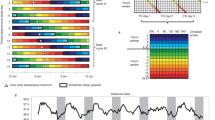Summary
In the realm of human circadian rhythms, the masking effect is defined as the change in the course of deep body temperature induced by changes in the degree of physical activity, or by the alteration between sleep and wake. This effect is particularly obvious during internal desynchronization where the rhythms of deep body temperature, and the sleep-wake sleep-wake sleep cycle — i.e. one of the masking factors — run with different periods.
Every sleep onset is accompanied by a rapid drop, and wake onset by a rapid rise in deep body temperature, each one with an overshoot of about 50% of the steady state variations. When rhythms are calculated, with the dominant temperature period as the screening period, exclusively from data obtained during sleep episodes, on the one hand, and from those obtained exclusively during wake, on the other, two average cycles emerge: the ‘sleep temperature curve’ and the ‘wake temperature curve’. Both run in parallel but are separated by the ‘masking effcct’. As derived from many experiments, the mean masking effect amounts to 0.28±0.06°C. The masking effect also depends to some extent on the phase of the temperature rhtthm; it is larger than average around the temperature maximum and during the descending phase of the temperature cycle, where the alertness commonly is highest and the probability to sleep, in general, and the REM sleep propensity, in particular, are smaller than average. This also can be interpreted to indicate that the sleep temperature curve is phase advanced relative to the wake temperature curve; this, on the average, by 0.9±0.3 h.
If the individually determined amount of masking is added to the temperature data obtained during sleep, or substracted from the temperature data obtained during wake, a temperature curve emerges that can be though of as being ‘purified’ of the masking effect. Analyses of this artificial curve allow estimation of that part of the internal interactions uninfluenced by the masking effect. On the average, about half of the amount of interaction between the rhythm of sleep-wake and that of deep body temperature is explained by the masking effect, whereas the other half is ‘oscillatory interaction’. Both types of interaction are inherent and inseparable parts of the circadian clock mechanism, as can be deduced from model considerations.
Similar content being viewed by others
References
Aschoff, J., Exogenous and endogenous components in circadian rhythms. Cold Spring Harbor Symp. quant. Biol.25 (1960) 11–27.
Wever, R., Zum Mechanismus der biologischen 24-Stunden-Periodik. III. Mitteilung. Anwendung der Modell-Gleichung. Kybernetik2 (1964) 127–144.
Wever, R., Einfluss schwacher elektro-magnetischer Felder auf die circadiane Periodik des Menschen. Naturwissenschaften55 (1968) 29–32.
Wever, R. A., The Circadian System of Man. Springer-Verlag, New York, Heidelberg, Berlin 1979.
Wever, R., Die Tagesperiodik des Menschen — Grundlagen und Probleme. Betriebsärztliches J.1 (1980) 1–32.
Wever, R. A., Behavioral aspects of circadian rhythmicity, in: Rhythmic Aspects of Behavior, pp. 105–171. Eds F. M. Brown and R. C. Graeber. L. Erlbaum Ass. Publ., Hillsdale, N.J. 1982.
Wever, R. A., Organization of the human circadian system: internal interactions, in: Circadian Rhythms in Psychiatry, pp. 17–32. Eds T. A. Wehr and F. K. Goodwin. Boxwood Press (Neurosciences Series), Los Angeles 1983.
Wever, R. A., Toward a mathematical model of circadian rhythmicity, in: Mathematical Models of the Circadian Sleep-Wake Cycle, pp. 17–77. Eds M. C. Moore-Ede and C. A. Czeisler. Raven Press, New York 1984.
Wever, R. A., Sex differences in human circadian rhythms: intrinsic periods and sleep fraction. Experientia40 (1984) 1226–1234.
Zulley, J., Schlaf und Temperatur unter freilaufenden Bedingunen, in: Berichte des 30. Kongresses der Deutschen Gesellschaft für Psychologie, pp. 398–399 (1976).
Zulley, J., Der Einfluss von Zeitgebern auf den Schlaf des Menschen. Fischer-Verlag, Frankfurt a. M. 1979.
Zulley, J.:, and Wever, R. A., Interaction between the sleep-wake cycle and the rhythm of rectal temperature, in: Vertebrate Circadian Systems: Structure and Physiology, pp. 253–261. Eds J. Aschoff, S. Daan and G. A. Groos. Springer-Verlag, Berlin, Heidelberg, New York 1982.
Author information
Authors and Affiliations
Rights and permissions
About this article
Cite this article
Wever, R.A. Internal interactions within the human circadian system: the masking effect. Experientia 41, 332–342 (1985). https://doi.org/10.1007/BF02004495
Published:
Issue Date:
DOI: https://doi.org/10.1007/BF02004495




